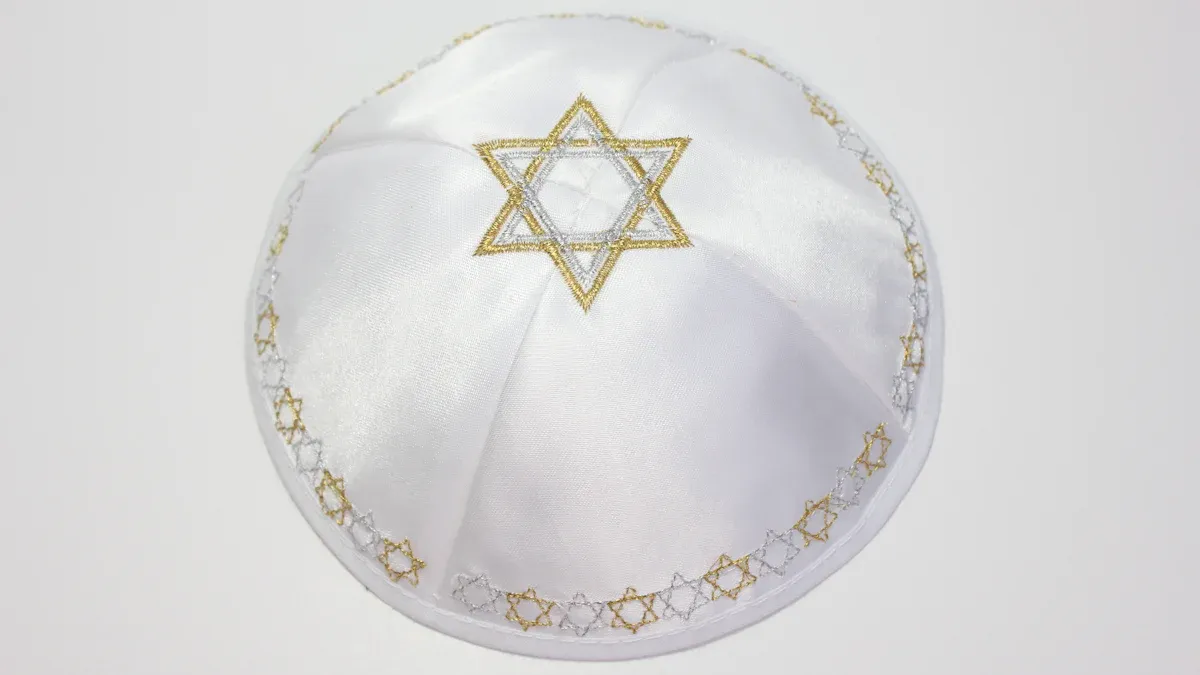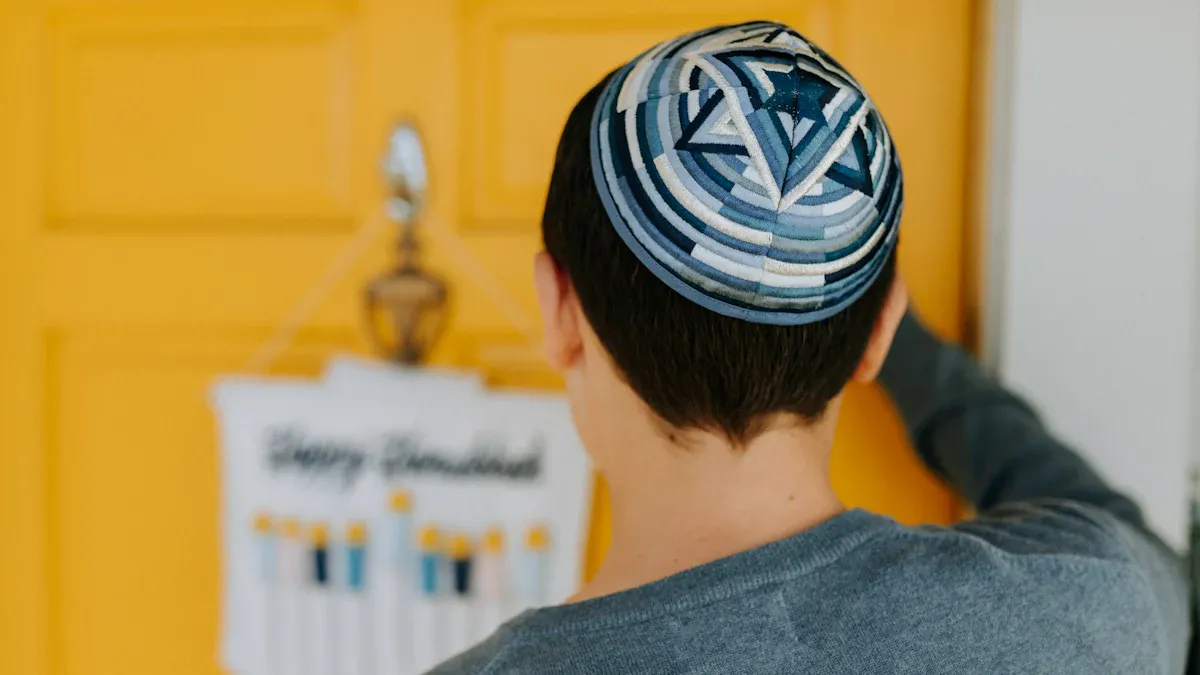
A knitted kippah holds great significance in Jewish culture, especially when considering the Jewish way in love and marriage. Many people view the kippah, or yarmulke, as a symbol of respect and humility before God. At Jewish weddings, wearing a knitted kippah represents unity and commitment, much like a wedding ring does in the Jewish way in love and marriage. The yarmulke also helps individuals feel connected to their community and reflects their values. Religious Zionists often choose a knitted kippah to express their identity. The yarmulke, also known as a kippah, is a visible reminder of Jewish love and the Jewish way in love and marriage, with the knitted kippah playing a special role in this tradition.
Key Takeaways
Knitted kippahs show respect, humility, and faith in Jewish life. They remind people that God is always near. At Jewish weddings, knitted kippahs stand for unity and commitment. They also show the bond between the couple and their community. Couples make knitted kippahs special with colors, patterns, and embroidery. This shows family traditions and makes keepsakes that matter. Giving knitted kippahs to guests helps everyone feel together. It lets all guests share in the wedding moment. Knitted kippahs link Jewish people from old to young. They show pride in heritage and the value of shared beliefs.
Symbolism
Reverence and Humility
The kippah, or yarmulke, is an important symbol in Jewish life. Jewish teachers say wearing a kippah, even a knit one, shows respect and humility to God. The yarmulke reminds people that God is always above them. It helps guide their thoughts and actions every day. This tradition started long ago, during Talmudic times. Back then, covering the head showed respect and fear of God. The kippah is sometimes compared to the High Priest’s hat. That hat reminded people of God’s presence.
The knit kippah helps Jewish people remember to act with respect. It reminds them not to do things that are wrong. This is not just a rule, but a custom that is now a big part of Jewish life. Both men and women can wear a knit kippah to show their devotion and faith.
Jewish communities see the yarmulke as a sign of faith. The kippah srugah, or knitted kippah, is very popular with religious Zionists. The style does not come from a religious law, but the ideas of humility and respect are for all kippahs. The knit kippah helps people remember God and their duty to be kind and respectful.
Commitment and Unity
The yarmulke also stands for commitment and unity, especially in Jewish love and marriage. At weddings, the kippah is like a wedding ring. It shows the person is part of the Jewish community. It also shows they care about love, respect, and being faithful. The knit kippah is a symbol of the couple’s shared beliefs and their promise to build a life together.
Many Jewish groups use the yarmulke to show unity at big events. For example, at weddings, guests might get a knit kippah to wear. This helps everyone feel together. In the 1980s, Modern Orthodox teens in America wore knitted kippot with their names on them. This showed love and personal devotion. The size, color, and style of the kippah can show family tradition, culture, or social identity.
The kippah srugah is special in religious Zionist groups. It first showed up in the 1940s with students at Yeshivat Kfar HaRoeh. Pninah Chen-Tzion made the first knit kippah for her boyfriend, Ovadiah Chen-Tzion. He was helping build the new state. Rabbi Moshe Tzvi Neria, a leader, told people to use it. The knit kippah soon became a symbol of religious Zionism. It mixed religious life with national pride.
Jewish people use the yarmulke to show their bond with their community and their shared values. The knit kippah stands for unity, love, and the promise that marriage brings. It is more than just something to wear. It is a sign of belonging and a reminder of the special bond between people, families, and the whole Jewish community.
Jewish Way in Love and Marriage: Knitted Kippah

Tradition and Law
The jewish way in love and marriage knitted kippah is important at weddings. Jewish law does not say you must wear a certain kippah style. Many people pick a knit kippah because it means something special. At the ceremony, the groom and most male guests wear a kippah or yarmulke. This shows they respect tradition and honor God. The kippah reminds everyone that a wedding is more than a legal event. It is a holy time in the jewish way in love and marriage knitted kippah.
The yarmulke helps set the mood for the wedding. It shows the event follows jewish customs. The couple stands under the chuppah, and the kippah shows their faith. Some families give a knit kippah from parent to child. This connects the couple to their family and the jewish community. Wearing the kippah at the ceremony marks the start of a new family. It begins a new part of the jewish way in love and marriage knitted kippah.
Community and Identity
The jewish way in love and marriage knitted kippah helps build community and show who you are. The kippah links the couple to their guests and the jewish community. Many families make the kippah special for the wedding. They might add the date, a Hebrew blessing, or a design. This makes the kippah more than just a hat. It becomes a keepsake for guests to take home.
The kippah is like a blank page for identity. It shows family history and tradition. Some families make kippahs with embroidery or family symbols. These kippahs can be passed down as family treasures. This keeps jewish pride and culture strong.
At the wedding, the kippah helps everyone feel together. Guests wearing the same kippah feel like part of the group. The yarmulke, especially the knit kippah, shows belonging. It proves the jewish way in love and marriage knitted kippah is about more than two people. It joins families and makes the community stronger.
Knitted kippahs often have wedding dates, Hebrew vows, or special embroidery.
They are important at weddings, showing personal and group identity.
The kippah is a way to show heritage and tradition.
Family kippahs are passed down, keeping jewish pride alive.
Using knitted kippahs at weddings shows they mean more than just religion. They are important for culture and family.
The yarmulke and kippah both show unity and identity. The jewish way in love and marriage knitted kippah brings people together. It reminds everyone about shared values and why tradition matters at every wedding.
Wedding Traditions

Personalization
Couples like to make knitted kippahs special for their wedding. They pick colors, patterns, and materials that match the wedding. These choices can also show family or community traditions. Many people buy lots of kippahs online for the event. It is easy to find styles that fit the wedding. Knitted kippahs can have embroidery or printing. They might show the couple’s names, the wedding date, or a logo. These details make each kippah a special memory from the wedding.
Some families like certain colors or symbols on their kippahs. White often means purity and new beginnings. Blue and gold can have spiritual meaning. Patterns can show religious symbols, shapes, or flowers. The material is important too. Knitted kippahs are common at casual or modern Orthodox weddings. Satin or velvet kippahs are used at formal events.
Aspect | Details |
|---|---|
Blue, white, silver, and gold often match the wedding and have special meaning. | |
Patterns & Motifs | Religious symbols, shapes, and flowers show tradition or modern style. |
Customization | Names and wedding dates are added to make them personal. |
Material & Style | Knitted kippahs are for casual weddings; satin or velvet are for formal ones. |
Symbolism | White kippahs stand for purity and new beginnings. |
Keepsakes for Guests
On the wedding day, couples give special kippahs to their guests. This is a meaningful way to use yarmulkes at the wedding. Each guest gets a kippah as a keepsake. This helps everyone feel included and together during the ceremony. The kippah is a reminder of the special day and the friendships made at the wedding.
Many guests keep their kippahs to remember the happiness and togetherness of the wedding.
Couples sometimes put the kippahs on a table near the door. They might also place one on each guest’s seat. This makes the room look nice and helps everyone join in. Giving kippahs as keepsakes shows how important community is at Jewish weddings. It lets guests take home a piece of the celebration. This helps them remember the wedding for many years.
The knitted kippah is a strong symbol in Jewish love and marriage. It shows faith and culture together. It is a sign of religious devotion. It also shows who belongs to the community. Many couples today pick special knitted kippot to show unity and pride. Communities use them to help people feel close and respect tradition. This small head covering connects people from different times. It reminds everyone about shared values and the beauty of Jewish weddings.
FAQ
What does a knitted kippah symbolize at a Jewish wedding?
A knitted kippah means you respect tradition and faith. It also shows the couple and their community are united. Many people think it is a sign that you belong.
Can women wear knitted kippahs at weddings?
Yes, women can wear knitted kippahs at weddings. Some families want everyone to wear one. This helps all guests feel included and respected at the ceremony.
Why do couples personalize their wedding kippahs?
Couples want their wedding to feel unique and special. They pick colors, patterns, or embroidery that tell their story. These kippahs become keepsakes for the guests.
Do all Jewish communities use knitted kippahs?
Not every Jewish community uses knitted kippahs.
Some like satin or velvet kippahs instead.
Religious Zionist groups often pick knitted kippahs to show who they are.









